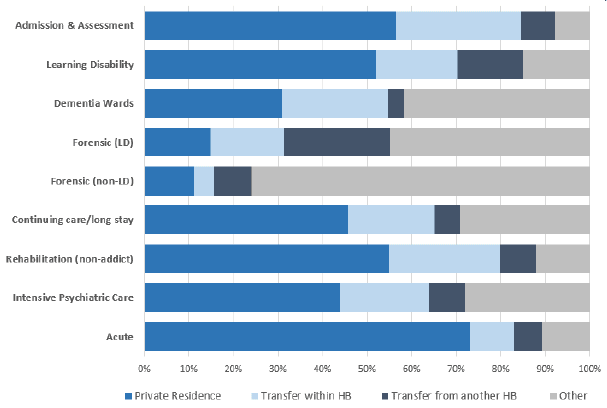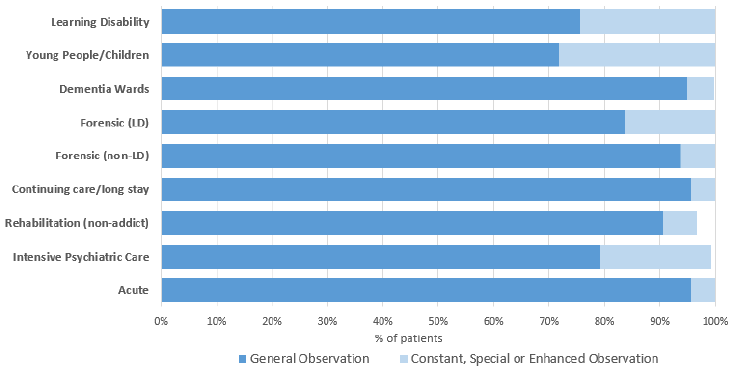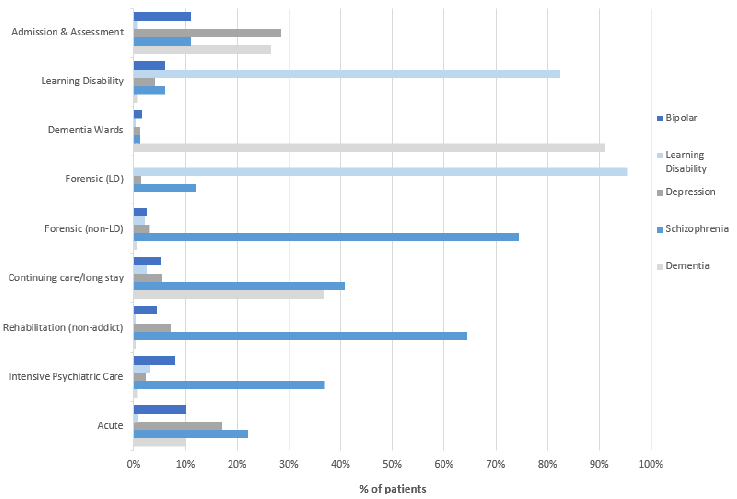Inpatient census 2018: parts one and two
Results of the fourth Mental Health & Learning Disability Inpatient Census and Out of Scotland NHS Placements Census, 2018.
5. Further Breakdowns by Ward Type
- The majority of available beds in Scotland are in acute wards (33%)
- Length of stay varied greatly between ward types, from average 36 days in acute wards to 1,398 days in forensic (LD) wards
- 28% of patients in learning disability wards were delayed discharges
Pressures and demands vary across different ward types. Some such as continuing care/long stay wards may have more stable populations compared with acute wards. This section provides some of the previously presented statistics broken down at ward level.
Overall the occupancy rate for NHS Scotland was 84%, though this varied greatly between ward types, with eating disorder wards having an occupancy of 55% and perinatal wards 100%. Wards also differ in the number of available beds. One in three mental health, addiction and learning disability beds in Scotland were in an acute ward, while one in five were in dementia wards. Eating disorder and addiction wards had the lowest number of available beds.
Table 15: Available beds & occupancy rates, by ward type, 2018 Census
| Ward Type | 2018 Census | |
|---|---|---|
| No. Beds | Occupancy | |
| Acute | 1,331 | 86% |
| Intensive Psychiatric Care | 144 | 87% |
| Rehabilitation (non-addict) | 311 | 85% |
| Addiction Wards1 | 40 | 83% |
| Continuing care/long stay | 402 | 68% |
| Perinatal | 12 | 100% |
| Forensic (non-LD) | 410 | 90% |
| Forensic (LD) | 79 | 85% |
| Dementia Wards2 | 814 | 87% |
| Young People/Children3 | 54 | 98% |
| Learning Disability | 170 | 87% |
| Eating Disorder | 22 | 55% |
| Admission & Assessment | 173 | 89% |
| Other | 113 | 76% |
| Scotland | 4,075 | 84% |
1 Addiction wards are the combination of addiction rehabilitation and addiction detox wards.
2 Dementia wards are the combination of dementia assessment and dementia care & treatment wards.
3 Young People/Children wards are the combination of Young people's units and children's units.
Reason for Admission and Admission From
Information was returned on the reason for a patient being admitted to hospital. Where a reason was available, the most common in most ward types was "Therapeutic/Clinical Crisis". However, in rehabilitation (non-addict) wards the most common reason was "rehabilitation" (36%), while in Forensic (LD) and Learning Disability wards the most common reason was for "Learning Disability", 55% and 47%, respectively.
The majority of patients in the 2018 Census were admitted from a private residence. This was the case for most ward types though not all. For example, 42% of patients in a Forensic (non-LD) ward were admitted from a legal establishment, which can include prison. One in four patients in dementia wards were admitted from a care home.
Figure 30: Number of patients, by where admitted from, selected ward types, 2018 Census

Length of stay varied significantly between different ward types. The longest length of stay was observed in Forensic (LD) wards with an average (median) length of stay of 1,398 days (over 3 years). The shortest length of stay was observed in addiction wards with average (median) lengths of stay of around 1 week.
Table 16: Average (median) length of stay, by ward type and Census
| Ward Type | 2016 Census | 2017 Census | 2018 Census |
|---|---|---|---|
| Average (median) Length of Stay | Average (median) Length of Stay | Average (median) Length of Stay | |
| Acute | 41 | 41 | 36 |
| Intensive Psychiatric Care | 65 | 57 | 54 |
| Rehabilitation (non-addict) | 770 | 840 | 537 |
| Continuing care/long stay | 1,462 | 1,255 | 1,170 |
| Forensic (non-LD) | 861 | 832 | 779 |
| Forensic (LD) | 1,709 | 1,371 | 1,398 |
| Learning Disability | 840 | 1,401 | 447 |
| Eating Disorder | 90 | 85 | 88 |
Boarding from another hospital
If a patient is "boarding" from another hospital, then they are staying in a hospital outwith their local catchment area. This could be because there were no beds available in a closer hospital or that their local hospital did not have the required services for the appropriate treatment of the patient.
A total of 39 patients were boarding in from another hospital at the 2018 Census. The majority of "boarding" patients were in an acute ward setting (59%).
Observation level
As discussed earlier in the report, patients receive varying levels of observation depending on their individual level needs which can impact on staff resources within a ward. See page 13 for details on the current guidelines related to observation levels.
The majority of patients in the 2018 Census, 3,190 (93%), were under general observation. However this did vary by ward type. While wards such as acute (96%), addiction (97%), continuing care/long stay (96%) and dementia wards (95%) had high levels of patients under general observation, some had higher proportions of patients under Constant, Special or Enhanced observation. For example 28% of those in a young people/children's unit were under these observation levels, while the same was true for 24% of those in learning disability wards.
Figure 31: Proportion of patients, by observation level, by ward, 2018 Census

* Not all wards reach 100% as some patients come under 'Not applicable' which can relate to patients being treated in care homes where an observation level may not apply, or patients on pass
For patients under Constant, Special or Enhanced Observation, further information on the number of staff involved in the observation was collected. As many as 65% of patients in forensic (non-LD) wards required two or more staff for observation, while the same was true for 36% of patients in learning disability wards.
The most common reason for a patient being on a Constant, Special or Enhanced Observation level was due to "risk of self-harm" and "risk of harm to others". However this varied by ward type. In dementia wards, the main reason for observation was "risk of falls", while in acute and rehabilitation (non-addict) wards there was a high proportion of patients on observation due to "risk of absconding".
Status
Patients who have been detained under the provisions of the Mental Health (Care and Treatment) (Scotland) Act of 2003 are defined as having "Formal" status. "Informal" refers to voluntary Mental Health admissions. Almost half of patients (48%) were admitted with a "Formal" status while this increased slightly at the time of the 2018 Census to 49%.
There was wide variation across different ward types in regards to the status of patients. In Forensic Wards (non-LD and LD), almost every patient was under "Formal" status, whereas this applied to only a small proportion in addiction wards. Almost every ward observed an increase in the number of patients under "Formal" status from time of admission to the Census date.
Table 17: Patients with "Formal" status at time of Census, by Ward Type and Census
| Ward Type | 2016 Census | 2017 Census | 2018 Census |
|---|---|---|---|
| Acute | 37% | 40% | 41% |
| Intensive Psychiatric Care | 88% | 94% | 92% |
| Rehabilitation (non-addict) | 65% | 69% | 71% |
| Continuing care/long stay | 22% | 28% | 37% |
| Forensic (non-LD) | 98% | 99% | 100% |
| Forensic (LD) | 96% | 96% | 99% |
| Dementia Assessment | 24% | 26% | 26% |
| Dementia Care & Treatment | 19% | 20% | 17% |
| Learning Disability | 66% | 75% | 80% |
| Eating Disorder | 44% | 43% | 50% |
| All | 44% | 47% | 49% |
Hospital Based Complex Clinical Care
A patient is defined as receiving HBCCC if they have care needs that cannot be met in any setting other than hospital and require long-term complex clinical care, or have been in hospital for over 6 months. Under the definition of HBCCC, a patient cannot be a delayed discharge.
At the 2018 Census, there were 731 (21%) patients receiving HBCCC who were occupying a mental health or learning disability inpatient bed. Around 44% of all HBCCC patients were in dementia wards, while a further 23% were in continuing care/long stay wards.
Table 18: Number of HBCCC patients, by Ward Type, 2018 Census
| Ward Type | Number of HBCCC patients | % of ward HBCCC |
|---|---|---|
| Acute | 37 | 3% |
| Intensive Psychiatric Care | 12 | 10% |
| Rehabilitation (non-addict) | 65 | 25% |
| Continuing care/long stay | 171 | 62% |
| Forensic (non-LD) | 64 | 17% |
| Dementia Wards1 | 321 | 45% |
| All | 731 | 21% |
1 Dementia wards are the combination of dementia assessment and dementia care & treatment wards.
Delayed Discharge
Timely discharge from hospital is an important indicator of quality and is a marker for person-centred, effective, integrated and harm free care. A delayed discharge occurs when a hospital patient who is clinically ready for discharge from inpatient hospital care continues to occupy a hospital bed beyond the date they are ready for discharge.
At the 2018 Census, 258 patients were a delayed discharge. Many of these delayed discharge patients were in acute wards, 68 (26%). However, the largest proportion of beds lost to delayed discharge was in learning disability wards (28% lost), where the average (median) number of days delayed was over one year. This compares to the overall average of 72 days.
Table 19: Delayed discharge, by Ward Type, 2018 Census
| Ward Type | % beds lost to delayed discharge | Average (median) number of days delayed |
|---|---|---|
| Acute | 5% | 41 |
| Rehabilitation (non-addict) | 7% | 111 |
| Forensic (LD) | 22% | 178 |
| Dementia Assessment | 9% | 23 |
| Dementia Care & Treatment | 10% | 48 |
| Learning Disability | 28% | 384 |
| All | 6% | 72 |
Demographics
The majority of patients within the 2018 Census were male (58%). Most ward types followed the same overall pattern with the obvious exception of perinatal wards where 100% were female. The split in acute wards was almost even (49% male versus 51% female), while the vast majority of patients in eating disorder wards were female. Forensic wards, both learning disability and non-learning disability, were almost all male.
Table 20: Gender breakdown, by Ward Type, 2018 Census
| Ward Type | % male | % female |
|---|---|---|
| Acute | 49% | 51% |
| Intensive Psychiatric Care | 65% | 35% |
| Rehabilitation (non-addict) | 61% | 39% |
| Addiction Wards1 | 67% | 33% |
| Continuing care/long stay | 57% | 43% |
| Perinatal | 0% | 100% |
| Dementia Wards2 | 56% | 44% |
| Young People/Children3 | 26% | 74% |
| Learning Disability | 56% | 44% |
| Admission & Assessment | 46% | 54% |
| All | 58% | 42% |
1 Addiction wards are the combination of addiction rehabilitation and addiction detox wards.
2 Dementia wards are the combination of dementia assessment and dementia care & treatment wards.
3 Young People/Children wards are the combination of Young people's units and children's units.
Most patients were aged between 18 - 64 in the 2018 Census. However this varied by ward type. As would be expected, the majority of patients (94%) in dementia wards were aged 65 and over. The majority of patients in continuing care/long stay wards (60%) and admission & assessment wards (84%) were also aged 65 and over. All patients in eating disorder wards were aged between 18 - 39, while 85% of patients in addiction wards were aged between 40-64.
Table 21: Age breakdown, by Ward Type, 2018 Census
| Ward Type | 0 - 39 years | 40 - 64 years | 65+ years |
|---|---|---|---|
| Acute | 351 | 500 | 290 |
| Intensive Psychiatric Care | 63 | 62 | 0 |
| Rehabilitation (non-addict) | 77 | 159 | 28 |
| Addiction Wards1 | * | 28 | * |
| Continuing care/long stay | 17 | 92 | 166 |
| Perinatal | 12 | 0 | 0 |
| Dementia Wards2 | 0 | 38 | 667 |
| Eating Disorder | 12 | 0 | 0 |
| All | 879 | 1,197 | 1,366 |
1 Addiction wards are the combination of addiction rehabilitation and addiction detox wards.
2 Dementia wards are the combination of dementia assessment and dementia care & treatment wards.
* Suppressed due to small numbers
Mental health morbidities
NHS Boards returned diagnosis codes (ICD 10) for any mental health condition for which patients in the 2018 Census had a diagnosis. The majority of patients in the Census had one mental health condition recorded (75%). This was the case for most ward types, however around 60% of patients in learning disability wards had 2 or more diagnoses.
There were differences between ward types in the type of conditions that patients had been diagnosed. Schizophrenia was the most common diagnosis in the majority of wards. However, while this diagnosis was most common in wards such as acute and intensive psychiatric care, these wards tended to have a wider range of conditions. Speciality wards tend to be filled by patients with a diagnosis for that condition, for example, 91% of patients in dementia wards had this diagnosis, while 96% of patients in forensic (LD) wards had a learning disability diagnosis.
Figure 32: Patients by selected mental health diagnosis, by ward, 2018 Census

* Mental health diagnoses are based on ICD 10 codes. Primary and secondary diagnoses included
** Patients may have more than one diagnosis
Contact
Email: Guy McGivern
There is a problem
Thanks for your feedback